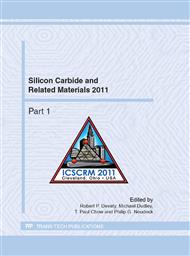p.433
p.437
p.441
p.445
p.449
p.453
p.457
p.461
p.465
Silicon Carbide-Silicon Dioxide Transition Layer Mobility
Abstract:
We present transition layer electron mobility versus field curves for several 4H-SiC/SiO2 structures, simulated by a newly developed Monte Carlo simulator that uses density of states calculated by density functional theory (DFT). Our calculations show that among all structures, abrupt SiC/SiO2 has the highest transition layer mobility.
Info:
Periodical:
Pages:
449-452
Citation:
Online since:
May 2012
Price:
Сopyright:
© 2012 Trans Tech Publications Ltd. All Rights Reserved
Share:
Citation:


